Sen. Marco Rubio (R-FL), the vice chairman of the U.S. Senate Select Committee on Intelligence, compiled over the past several years and just released on Tuesday a several hundred page report detailing his investigative findings on the origins of the coronavirus pandemic.
The report, which is available on Rubio’s Senate website, is more than 240 pages long, with another more than 80 pages containing the hundreds of citations made throughout it. The effort is the product of years of research by Rubio, his staff, and outside experts who helped compile the comprehensive investigation into the matter.
“After years of censorship, there is growing evidence that some type of lab accident is responsible for the Covid-19 pandemic,” Rubio said in a statement accompanying the release of the report. “This report, which took two years to compile, edit, and refine, is a groundbreaking look at what was happening in China during the years and months leading up to the known outbreak of the pandemic. I am grateful to the staff, fellows, and outside experts who worked to connect the dots. Their work helps fill in some critical blanks and has already contributed to other reports, hearings, and investigations. The implications are impossible to ignore: Beijing hid the truth. This report reinforces the need to hold the Chinese Communist Party accountable.”
Rubio’s extensive investigation concludes that COVID likely leaked out of the Wuhan Institute of Virology (WIV) in late 2019 before it spread across the world and became the worst pandemic in decades.
“This study identified a variety of significant indicators that the PRC [People’s Republic of China] authorities and relevant figures in the scientific community possessed some level of awareness of an outbreak of infectious disease well in advance of the first disclosure of this information to the public on December 31, 2019,” Rubio’s report reads in the executive summary. “Information detailed in this report, including that derived from official Chinese sources, further indicates that a serious biocontainment failure or accident, likely involving a viral pathogen, occurred at the state-run Wuhan Institute of Virology (WIV) of the Chinese Academy of Sciences (CAS) during the second half of 2019 – approximately during the same period of time in which the available epidemiological evidence indicates that SARS-CoV-2 was introduced to the human population in Wuhan.”
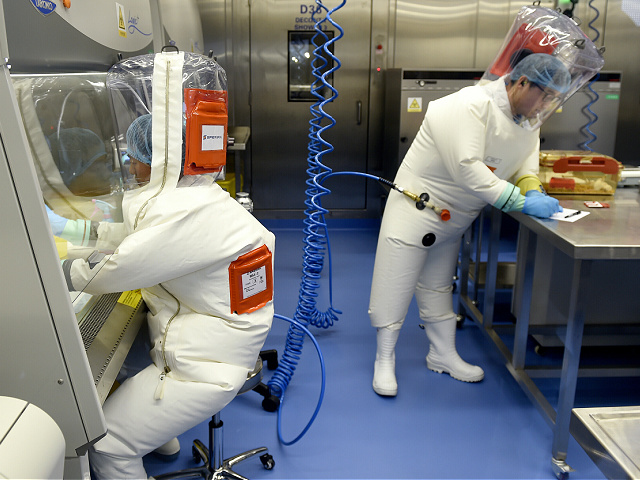
In this photo taken Thursday, Feb. 23, 2017, researchers work in a lab of the Wuhan Institute of Virology in Wuhan in central China’s Hubei province Claims promoted by the Trump administration that the global coronavirus pandemic originated at the Wuhan Institute of Virology in the central Chinese city are a “pure fabrication,” the institute’s director said Sunday, May 24, 2020. (Chinatopix via AP) CHINA OUT
Rubio’s report’s summary also reveals that senior leaders of the Chinese Communist Party (CCP) “likely had at least limited knowledge of this laboratory incident by no later than the middle of November 2019.”
“This incident occurred within a climate of intense political pressure on the CAS [Chinese Academy of Sciences] to stand up the WIV’s new flagship BSL-4 laboratory complex, the first of its kind in China, and to produce technological breakthroughs in short order that would free China of its so-called ‘stranglehold’ problem,” the report reads.
The report, arguably the most intensive investigation into this matter published yet by any authority worldwide, continues by noting that “awareness” by Chinese officials of the lab accident “seemed to have shaped the CCP leadership’s response” to the early days of the pandemic, “a response characterized by strict controls of information, obfuscation, misdirection, punishment of whistleblowers, and the destruction of key clinical evidence.”
Rubio’s investigation found that “even when Beijing shared information with the international community – such as the initial notice of a pneumonia outbreak, the later admission that a novel coronavirus was its causal agent, and the publishing of its genomic sequence – it did so belatedly.”
“In all three cases, Beijing possessed the relevant information for some time before sharing it, and disclosed it only when compelled to do so by circumstances beyond its control,” the report reads.
The report is broken into multiple sections. First, Rubio’s team sets the stage laying out critical background information about how the Chinese Communist Party for decades leading up to 2019 sought to make Communist China a world-leading authority in scientific advancement
“As early as 1986, biotechnology was designated as one of seven major research areas under China’s national high-technology research and development (R&D) plan called the ‘863 Program,’ which is regarded as its second most important civilian-military R&D program after the ‘Two Bombs and One Satellite’ science and technology development plan of 1956-67 that led to the development of a nuclear bomb and intercontinental ballistic missile,” the report reads. “In 1988, the PRC State Council laid out long-term plans aimed at developing biotechnology, which involved the construction of state-of-the-art laboratories and attracting foreign researchers and Chinese scientists trained abroad to conduct experiments in China. By 2004, the State Council had set up a National Leading Group on Research, Development, and Industrialization of Biotechnology, with representatives drawn from the Ministries of Science and Technology, Education, Finance, Agriculture, and Health.”
As part of this decades-in-the-works CCP strategy, Rubio’s report reveals, Wuhan—a major Chinese city—sought to position itself “to become a major base, not only for basic research in the life sciences, including synthetic biology, but specifically for biopharmaceutical production.”
Xi Jinping himself, the CCP’s dictator, even highlighted the Wuhan Institute of Virology as far back as 2014, Rubio’s report notes, saying then that “the construction of the P4 laboratory is of vital importance to Chinese public health.”
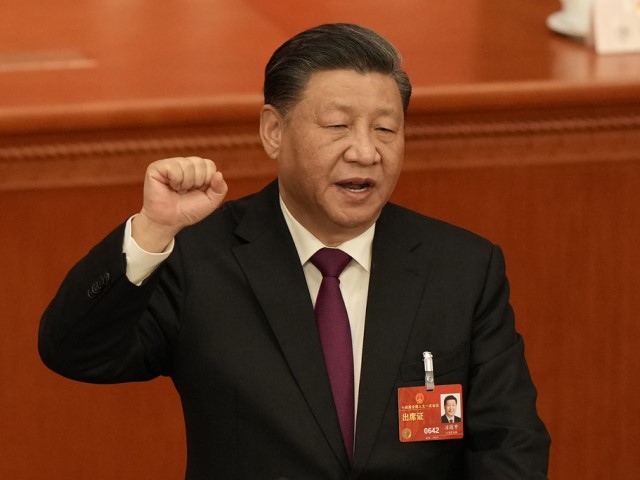
Chinese President Xi Jinping takes his oath after he is unanimously elected as President during a session of China’s National People’s Congress (NPC) at the Great Hall of the People in Beijing, Friday, March 10, 2023. Chinese leader Xi Jinping was awarded a third five-year term as president on Friday, putting him on track to stay in power for life. (AP Photo/Mark Schiefelbein)
The report from Rubio continues for several pages explaining the Chinese government’s history with bioweapons, the weaponization of pathogens, its history with building certain types of labs and weaponizing sickness in the past, and the Chinese government’s interest particularly in coronaviruses. The report also goes into depth about the connections between all of these Chinese scientific and medical research institutions and the People’s Liberation Army (PLA), the main military force for the CCP.
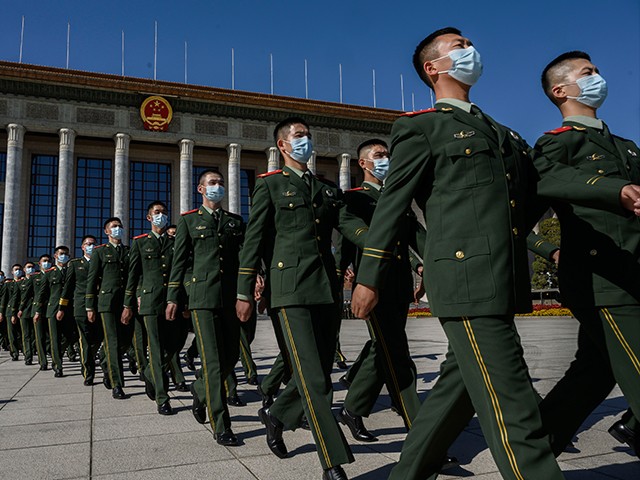
BEIJING, CHINA – OCTOBER 23: Chinese soldiers from the People’s Liberation Army wear protective masks as they march after a ceremony marking the 70th anniversary of China’s entry into the Korean War, on October 23, 2020 at the Great Hall of the People in Beijing, China. Chinese President Xi Jinping spoke at the event which was also attended by senior government and military officials and veterans of the war. (Photo by Kevin Frayer/Getty Images)
It also zones in on what Rubio’s report says was the “emergence of a doctrine called Military-Civil Fusion (MCF),” which has CCP leaders – particularly Xi himself – pushing a “view” that “the current decade as a potentially decisive period in a zero-sum race with the United States for global technological dominance in both civilian and military domains.”
“In March 2015, Xi elevated MCF to a national development strategy, a move aimed at winning this technological race, after he warned the PLA in December 2014 that China was lagging behind the United States,” the report reads. “In 2017, Xi sought to energize the implementation of the MCF strategy by establishing the Military-Civil Fusion Development Commission (MCFDC), chaired by Xi himself, under the CCP Central Committee. Xi has used the MCFDC to overcome resistance from vested interests – especially state-owned defense contractors – delineate MCF roles and responsibilities across the government and the PLA, promulgate policy directives, and compel provincial and municipal governments to form local-level MCF development committees, but MCF remains a work in progress.”
After explaining more of the history here, and again more background on how leading scientists for years leading up to the coronavirus pandemic were concerned with this facility in Wuhan, Rubio’s report then delves into a key “chronology” of events leading up to and surrounding the outbreak of COVID.
- The chronology begins with a warning Xi made in a January 5, 2018, speech of the possibility of the emergence soon of a “SARS-like virus.” Rubio’s report cites a 2021 piece from CCP propaganda outlet the People’s Daily on that Jan. 5, 2018, speech, which noted Xi “raised eight aspects and 16 dangers, among them…[major infectious viruses like] SARS,…[which we] must also be on the alert for at all times [and] take strict precautions against.”
“It appears that the text of this speech has never been published in full, and the official summary published by Xinhua on the day that the speech was delivered in 2018 did not include the quote about SARS above,” Rubio’s report reads. Shortly thereafter, also in January 2018, Rubio’s report reveals that U.S. diplomats visited WIV in Wuhan and expressed concerns about a lack of safety protocols and a shortage of properly trained staff.
Then, in March 2018, China’s Minister of Science and Technology (MOST) promoted Chinese efforts to advance disease surveillance technology—and just days later the CAS held meetings on March 16, 2018, on how to implement Xi’s MCF vision of fusing military and civilian sectors. “More than 60 participants in total attended, and they represented one office of the CCP Central Committee, three offices of the Central Military Commission, one office of the PLA AMS, four offices at CAS headquarters in Beijing, and around 30 CAS research institutes (such as the WIV),” Rubio’s report reads.
A few days after that, Rubio’s report notes, Chinese officials began formally taking steps towards opening their first BSL-4 laboratory at the Wuhan Institute of Virology as the State Council made changes to its “Biosafety Management Regulations for Laboratories that Study Pathogenic Microorganisms.”
Mere days later, still in March 2018, Rubio’s report reveals that U.S.-aligned interests working with partners in China submitted a proposal to literally create viruses.
“On March 24, the New York-based EcoHealth Alliance, in partnership with the WIV, virologist Wang Linfa (a native of China who is based in Singapore), and Professor Ralph Baric at the University of North Carolina Chapel Hill, submitted a proposal for a project called DEFUSE to be considered for funding from the Committee for Preventing Emerging Pathogenic Threats at the Defense Advanced Research Projects Agency (DARPA),” Rubio’s report reads. “They requested $14.2 million for a study that would take the most interesting spike proteins that the WIV collected from unpublished SARS-related coronaviruses circulating in bat colonies in Yunnan province, and create full-length infectious clones that they would test in human airway cultures and transgenic mice expressing the human ACE2 receptor. Most significantly, the team proposed to artificially insert protease cleavage sites, specifically furin cleavage sites (FCS), into the unpublished bat coronaviruses to test whether such insertions would affect the ability of the viruses to jump to humans.”
Rubio’s report notes that what they were proposing then is eerily similar to what became COVID, and that world-renowned virologists have not been able to come up with any explanation as to how COVID could have naturally come into being.
“SARS-CoV-2, the virus that causes COVID-19, has an FCS, which is a four-amino acid insert at the junction of the receptor-binding (S1) and fusion (S2) domains of the spike protein,” Rubio’s report reads. “It is the first known SARS-related coronavirus (sarbecovirus lineage) to possess such a site. The FCS plays a critical role in the replication, transmissibility, and pathogenesis of SARS-CoV-2. It is not yet clear to scientists how this particular site appeared in a sub-genre of coronaviruses in which such sites have never been observed. In the words of Cornell University Virologist Gary Whittaker, ‘So far, a viable natural origin for the SARS-CoV-2 S1–S2 site through recombination or mutation of a bat-origin virus has proved to be elusive.’ While we cannot conclude with confidence on the basis of currently available information that the insertion of the FCS into SARS-CoV-2 was the deliberate result of of an experiment at the WIV, the proposed work described above sets the insertion of FCS sequences into SARS-like viruses as a specific goal.”
The next few months in 2018, Rubio’s report continues, were marked by specific CCP government actions taking major steps in these fields, including speeches from Xi, directives from key government science and finance ministries, and more.
By August 2018, WIV’s level 4 laboratory was up and running by the Chinese government’s own admission—but Rubio’s report notes there are conflicting reports as to when exactly it started operating. Nonetheless, the reports notes that just a month later in September 2018, the Wuhan Institute of Virology held several discussions about its “shortcomings and inadequacies” in the words of the then-head of WIV.
By October 2018, Xi was giving more public addresses pressuring scientists for a “breakthrough” on the CCP’s MCF strategy.
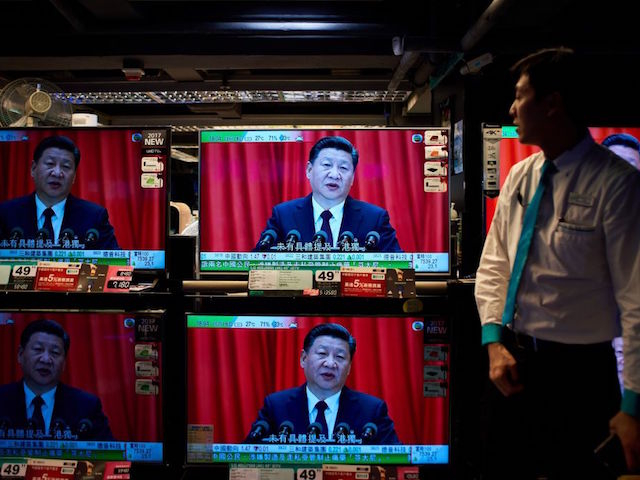
An electronics shop employee in Hong Kong on October 18, 2017 looks at television sets showing a news report on China’s President Xi Jinping’s speech at the opening session of the Chinese Communist Party’s five-yearly Congress at the Great Hall of the People in Beijing.
President Xi Jinping declared China is entering a “new era” of challenges and opportunities on October 18 as he opened a Communist Party congress expected to enhance his already formidable power. / AFP PHOTO / Anthony WALLACE (Photo credit should read ANTHONY WALLACE/AFP via Getty Images)
Rubio’s report reads:
Like Xi’s two speeches delivered earlier in 2018 on March 2 and March 12, the October 15 speech showed how high of a priority Xi placed on the MCF strategy and how much pressure he was putting on the PLA as well as civilian institutions like the CAS to carry out his vision. Xi’s speech highlighted the need for indigenous innovation and “breakthroughs” in producing “key and core technologies,” themes that would pervade discourse at the WIV throughout 2019. “You must put all your effort into making breakthroughs with key and core technologies, and establishing a foothold in the most complex and most difficult situations,” Xi said, “Achieve breakthroughs soon by using project development as the driving force and the concentrated advantages and strengths of a coordinated attack.” Xi saw barriers to military-civilian integration that he wanted torn down quickly: “You must greatly simplify the examination and approval of projects, lower the threshold for admission, and lower the systemic costs to unleash the productive power of society.”
The report continues detailing that, for the next several months, dozens of papers on biosafety and biosecurity written by people connected to the Wuhan lab, and there were concerns with a Chinese researcher operating out of a Canadian lab who also had ties to the Wuhan lab and allegedly sent specimens back there from Canada. That researcher was escorted out of the Canadian lab by Canadian police while they investigated, all while things continued to escalate in Wuhan—to the point where the government pressure for a Xi-inspired “breakthrough” at the Wuhan lab intensified. In May 2019, meanwhile, the report notes that “the PLA Air Force Airborne Corps Hospital located in Xiaogan Municipality, Hubei Province (approximately 37 miles northwest of Wuhan) made a purchase of polymerase chain reaction (PCR) testing equipment (a fluorescent quantitative PCR instrument), according to analysis by an Australian cybersecurity research firm.” The report notes that this is the first of many government-aligned institutions purchasing control over various public health systems like testing mechanisms and more.
By August 2019, Rubio’s report details how Chinese officials were openly discussing the threat of a lab leak of a virus—and how WIV officials were pushing for the “rectification and reform” of “critical problems.” Then, in September 2019, the WIV took down its online database of viruses.
“September saw a reduction in transparency at the WIV, a diminishment in its collaboration with scientists outside of China, and an enhancement in its physical security posture,” the report reads. “On September 12, apparently between the hours of 2:00 and 3:00 AM local time, the WIV took down its online depository of data on viral sequences called the Wildlife-Borne Viral Pathogen Database. This database was previously accessible to researchers inside and outside of China, with the exception of a password protection section, which held unpublished sequence data accessible only to WIV personnel. Records indicate an initial period of inactivity with the database between August 16-22, 2019, with a period of normal accessibility and activity restored from August 23 to September 12, when the database was taken offline for a prolonged period of time. At the time of publication of this report more than three years after it was first disabled, public access has not been restored.”
From that day forward, it appears things intensified significantly.
“On September 12, the same day that the WIV took the Wildlife-Borne Viral Pathogen Database offline in the early morning hours, the WIV issued a notice on the official procurement website for the PRC central government seeking bids from contractors to provide unspecified physical ‘security services’ for its facilities at the Zhengdian Park campus where the new BSL-4 lab is located,” the report continues. “Four days later, on September 16, the WIV issued another notice on the official procurement website for the PRC central government seeking contractors to bid for a ‘central air conditioning renovation project’ at the Zhengdian Park campus. The project was expected to take almost seven months (210 calendar days) to complete, and a budget of up to approximately US$586,709 (RMB 3,926,876.94) was allotted to pay for the renovation. It is unclear why modern laboratory facilities like those located at the WIV’s Zhengdian Park would require expensive renovations on a major system such as the HVAC unit so soon after they commenced operations. “
By Sept. 18, 2019, Chinese officials were conducting “emergency response drill activities” at the Wuhan airport and at least one of the exercises “focused on responding to the outbreak of a novel coronavirus at the airport.”
Rubio’s report cites contemporary media reports noting that the Wuhan airport officials worked with the WIV to develop the drill, which was ostensibly “in preparation for Wuhan’s hosting of the Military World Games in October.”
“The WIV’s involvement raises the possibility that it was WIV experts who suggested drilling an outbreak of a novel coronavirus,” Rubio’s report reads. “The WIV’s involvement is also consistent with a report that the WIV signed a ‘strategic cooperation agreement’ with the Wuhan Municipal Customs Administration in June 2019, in which ‘the two parties would launch extensive scientific and technological cooperation in [the areas of] risk analysis and early warning prediction of sudden, emerging infectious diseases, the research, development, and application of technology to detect highly pathogenic pathogens, the training and exchange of biosafety personnel, and the sharing of pathogen resource data….’ There is no public record that the September drills occurred on the official website of the Wuhan Tianhe International Airport. Some online media reports of the drills appear to have been removed, while others remained accessible.”
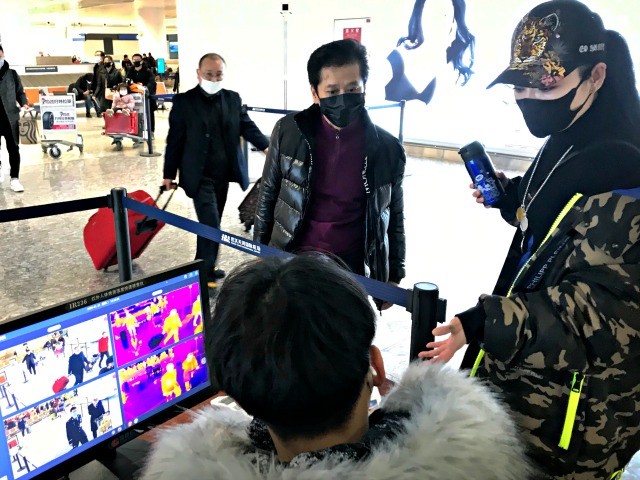
FILE – In this Jan. 21, 2020, file photo, travelers pass through a health screening checkpoint at Wuhan Tianhe International Airport in Wuhan in southern China’s Hubei province. For weeks after the first reports of a mysterious new virus in Wuhan, people poured out of the central Chinese city, cramming onto buses, trains and airplanes as the first wave of China’s great Lunar New Year migration broke across the nation. Some carried with them a new virus that has claimed over 560 lives and sickened more than 28,000 people. (AP Photo/Emily Wang, File)
Rubio’s report also notes that a suspected COVID patient was hospitalized as far back as September 2019, and even cites a Harvard analysis suggesting it might have even started earlier than that – as far back as August 2019.
“A team of scientists led by a Harvard Medical School professor in June 2020 suggested that the novel coronavirus may have begun spreading in Wuhan as early as August 2019 based on the unusual increase in hospital traffic observed during September and October 2019,” the report reads. “The team made this inference on the basis of a couple of indicators, the most significant of which was their analysis of satellite imagery of vehicular traffic at hospitals in Wuhan. The satellite data showed a significant increase in vehicles parked at major Wuhan hospitals – an indicator previously established as a proxy for hospital occupancy rates – during the fall of 2019 compared to the same period of time in 2018. The pronounced increase in parked cars was observed at five of the six hospitals that were examined, as much as a 90 percent rise in some cases.”
By the time of the Military World Games in October 2019, with visiting athletes from several other countries, the virus seemed to be in full, swing spreading through Wuhan like wildfire. Rubio’s report notes that many of these athletes “reported that they became ill while in Wuhan, or shortly after returning to their home countries, with symptoms consistent with COVID-19” and that 11 “Iranian athletes reportedly died of COVID-19, including some who participated in the Military World Games.”
By November 2019, China apparently could no longer keep the secret—and it announced the first confirmed case of COVID-19. “The China news editor of the South China Morning Post (SCMP), a veteran reporter with more than two decades of experience, reviewed official government data that documented a 55-year-old from Hubei Province (Wuhan is its capital), who contracted the virus on November 17, apparently the earliest confirmed case of COVID-19,” Rubio’s report reads. “From that date onwards, one to five new cases were reported each day. By December 15, the total number of infections stood at 27 – the first double-digit daily rise was reported on December 17 – and by December 20, the total number of confirmed cases had reached 60,’ according to the SCMP.”
Chinese officials, however, Rubio’s report notes, were continuing to obscure the details of COVID case numbers in China.
“At the time of its publication in March 2020, the SCMP indicated that Chinese authorities had identified at least 266 people who were infected in 2019, all of whom came under medical surveillance,” the report reads. “By contrast, the PRC authorities only acknowledged 174 cases of COVID-19 patients who fell ill in 2019 in their reporting to the WHO.”
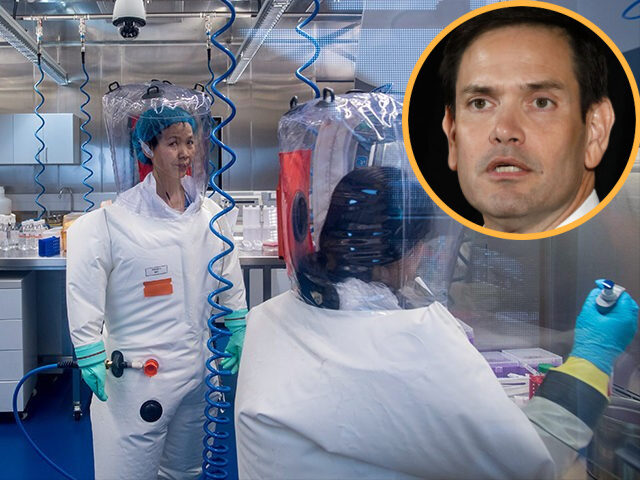
COMMENTS
Please let us know if you're having issues with commenting.